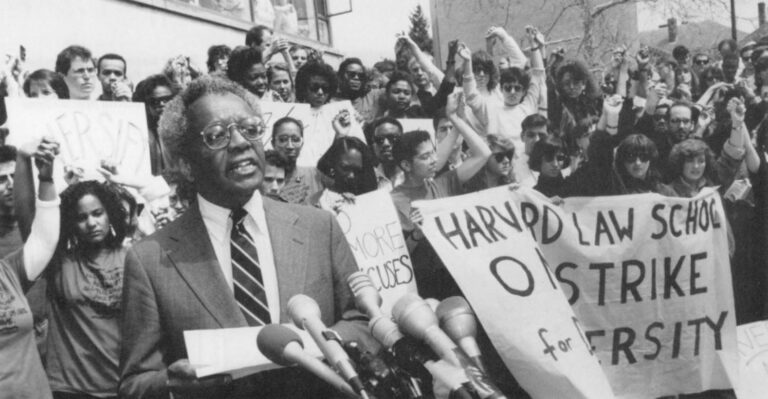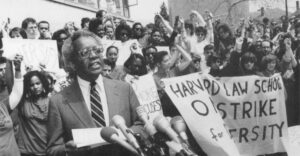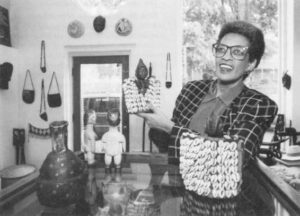Until recently, the broad debate over race relations at the nation’s colleges and universities focused largely on students. No longer.
Pushed by a series of dramatic events during the past year, that often fractious discussion has now expanded to include those who teach them as well: the faculty.
In doing so, it has become clear that the controversy erupting anew over the meaning and practice of affirmative action in higher education involves matters far more profound than arguing over the gathering, as if like Noah, of mere appropriate numbers of diverse peoples at this college or that university.
At deeper levels, it involves such things as exploring what the concepts of pluralism and meritocracy mean in a multiracial society. Also, what use should be made of standards, which are not immutable, but established and applied by human beings. And what standards should in this or that instance take precedence? And how to negotiate the tension that exists in pluralistic settings between the rights of individuals and the no less real, but largely unacknowledged, rights of groups to share in the national resources?
For those in higher education, resolving these issues requires understanding that seeking a diverse faculty is not only socially just but intellectually necessary.
The heated debates over using feminism and other non-traditional perspectives to judge especially Anglo-American literature is but one example of the impact these “new” scholars and their different intellectual concerns are making.
hese issues, so controversial now in higher education, are really questions for all of American society. But they are sharpest in higher education now because the paths of upward mobility now track almost solely through colleges and universities: They alone offer the training the credentials the vast majority of Americans need to become viable participants in the workplace, and thus, in the society as a whole.
In other words, it is precisely because fundamental matters are at issue that the debate has become so heated.
Numerous educators have noted an increased intensity in the complaints from both scholars and students that higher education is moving too slowly to diversify the professoriate–89 percent of whom are white, and 64 percent of whom are male.
“This has been a serious issue in higher education for more than two decades now,” said Derrick Bell, a senior tenured black professor at Harvard Law School. Except for a brief stint as dean of the University of Oregon’s Law School, he’s been on the Harvard faculty since gaining tenure in 1969. “But a sense of stagnation seemed to have settled over it in the ’80s. That’s why the agitation has been increasing. Something was needed to get things moving forward.”

Bell himself contributed mightily to placing the issue prominently on higher education’s agenda in April when he took an unpaid leave of absence to protest the faculty’s failure to have ever appointed a black woman to a tenured post.
Bell’s gesture stunned his colleagues and drew widespread media attention, due to his own stature and the fact it happened at the nation’s premier law school.
That coverage focused almost exclusively on whether black scholars are being discriminated against in faculty hiring and promotion decisions–or, on the other hand, whether colleges and universities are lowering standards in order to hire more of them.
The coverage was typical. Overwhelmingly, the press has examined the controversies and tensions accompanying the integration of higher education in the 1980s as if black ,students and scholars were the only ones pressing for change.
In fact, it’s apparent that the debate over faculty diversity, as well as that over student enrollments and curricular change, involves Asian/Pacific Americans, Native Americans, Hispanic Americans, and white women. Some of the most significant complaints of discrimination in faculty hiring in the past year have come from scholars who are members of those groups.
For example, the U.S. Supreme Court recently upheld a lower court decision ordering Boston University to grant unconditional tenure to Julia Prewitt Brown, an English professor. Professor Brown had been denied tenure in 1981 by the university’s president, John R. Silber, despite strong recommendations from her department and two more broadly constituted university committees. In lower-court testimony, faculty members said Silber had described the university’s English department as “a damn matriarchy,” although only six of its twenty faculty members were women.
Also, the Court last January pointedly rejected one of higher education’s most deeply-held traditions–the confidentiality of peer review–in ruling that colleges and universities accused of discriminating in tenure decisions had to turn over the relevant personnel files from federal investigatory agencies.
The decision came in a case in which a Chinese-American scholar, Rosalie Tung, who formerly taught at the Wharton School, charged that she was denied tenure there in 1985 because of racial and gender discrimination.
Additionally, two professors, writing in a recent special issue of the Harvard Educational Review, asserted in unusually blunt language that the advancement of Hispanic-American scholars is continually undermined by “pervasive racist attitudes.” They wrote that, “Our efforts toward full incorporation into academic positions in institutions of higher education are hampered by layers of academic stratification.”
The authors, Maria de la Luz Reyes, of the University of Colorado at Boulder, and John J. Halcon, of the University of Northern Colorado, stated that unless significant change occurs, Hispanic-American scholars will continue to be confined to “positions outside the mainstream ranks, those most peripheral to the hub of governance and power.”
It’s also apparent that, for all the tensions over race, ethnicity, gender, and sexual persuasion among today’s undergraduate and graduate students, some substantial number of them at predominately white institutions are troubled by the fact that as a group they are far more diverse than the faculties that teach them.
The week before Professor Bell announced his decision, for example, a multiracial coalition of undergraduate and graduate students at the University of California at Berkeley staged an 80-percent successful, two-day strike of classes to protest what they claimed was the University’s slowness in hiring and promoting more African-American, Asian-American, Hispanic-American, and Native-American scholars.
A quieter but no less dramatic demonstration of concern occurred at Harvard University’s commencement when Mary E. Black, an Irish physician who had spent the year gaining a master’s degree at the Harvard School of Public Health, gave one of the main graduation orations.
In poignant remarks, Dr. Black spoke of the violence caused by ethnic tensions she had witnessed in Ireland and many other countries during her eight-year career, contrasting those experiences with the camaraderie she found among her Harvard classmates “from over 50 countries and countless more different backgrounds, occupations, colours, political and religious beliefs.”
When Dr. Black, in a voice filled with the lilt of her native country, remarked that, “I had never before been in such a mixed group of students, and I hope that one day the faculty of this great university will be just as diverse,” the gathered throng burst into a prolonged ovation, revealing a shared depth of feelings on the issue that seemed to take everyone there by surprise.
Arthur E. Levine, chair of the Institute for Educational Management at Harvard University, says this concern is part of “the whole collage of issues dealing with diversity on campus. The Faculty is one of the most obvious areas in need of attention because that’s where the numbers are the worst.”
Of course, ‘white’ higher education has been far from uniformly hostile to white women scholars and scholars of color. Faculty at predominately white colleges and universities across the country have and continue to make significant efforts to develop and accept scholars from previously excluded groups.
Many of those who have chosen academic careers speak of their profession with great enthusiasm. Such efforts lured Deland Myers away from a promising career at Pillsbury to a tenure-track assistant professorship in food technology at Iowa State University.
“I wanted to get experience in the corporate world,” said Myers, who gained a doctorate in food technology from Iowa State in 1984, “but I always felt that if the right opportunity opened up, I’d go into teaching. My colleagues here have been very encouraging.”
However, despite notable progress in individual cases, many professors and university administrators readily acknowledge that substantive changes in numbers have been slow. Rhoda Dorsey, president of Maryland’s Goucher College, in remarks that are typical, characterizes the dearth of scholars of color in academe as “appalling.”
But they also identify one major reason for this lack of junior faculty and graduate students. The shortage is described in a welter of statistics compiled by the federal Department of Education and by numerous private organizations. They find that just 4 percent of the nation’s full-time and part-time faculty are of Asian descent, three percent are African-American, two percent are Hispanic-American and one percent are Native-American.
The total percentage of black faculty, however, actually obscures the degree of the problem at the nation’s 3,300 predominately white institutions, which is where the majority of black students in higher education are. The reason is that at least 40 percent of black faculty teach in the nation’s 117 historically black colleges.
The numbers for graduate school enrollments also deceive. A recent study by the National Research Council found that while the number of doctorates awarded by American universities reached a record 34,319 last year, the gain stemmed from the increasing number of doctorates obtained by foreign nationals. The 23,172 doctorates earned by all U.S. citizens, including those of minority groups, was nearly the same as in 1988.
The study also showed that African-Americans suffered a steep, 23-percent decline in doctoral degrees from 1979 to 1989, gaining only 811 last year. Whites also lost ground; the 20,688 gained representing a 6 percent loss from 1979.
In addition, while the percentage gains in doctorates awarded to Asian-Americans, Hispanic-Americans and Native Americans seem impressive, they rose 46 percent, 23 percent and 15 percent, respectively. The actual numbers are small: 624, 569 and 93.
This lack of progress contrasts sharply with the need for higher education to replace the professors who began teaching in the late 1940s through the early 1960s. It is expected to become critical.
The long-term prospects for minority graduate enrollment may be brighter than the current statistics show, according to Alan Fechter, executive director of the council’s Office of Scientific and Engineering Personnel. He told The Chronicle of Higher Education that at present, “I’d classify the minority situation a disaster area.”
Niara Sudarkhasa, president of Lincoln University, of Pennsylvania, agrees. She said that minority graduate enrollments, particularly those of African-Americans, have suffered from a host of problems, including the decline in federal aid for graduate study, the decade-long lack of growth in black undergraduate enrollments, academia’s inability to compete against the corporate sector for students of color and students’ perceptions that racial barriers to their advancement exist in academia.
These and other causes have led some colleges and universities to raid their counterparts for accomplished and promising faculty of color.
However, Alison Bernstein, associate dean of the faculty and Princeton University, among many others, says that the only true solution to the shortage is for colleges to increase the supply of minority faculty. “And these have to be specific steps,” she added. “It may mean creating a graduate program in Afro-American Studies, or targeting graduate fellowships, so that promising minority graduate students can be assured of support.”
There are a growing number of efforts designed to interest more undergraduates in academic careers, provide greater support to graduate students and to help those who are now junior faculty become better teachers and researchers. Among them, Williams College annually awards several fellowships that enable minority graduate students to spend an academic year finishing their dissertations.
New York University has organized a faculty development program involving 13 predominately white and 10 historically black colleges. Its primary purpose is to help faculty at the smaller schools by giving them access to N.Y.U.’s resources and fostering collaboration with its faculty on scholarly research and curriculum development.
Two broader efforts, the Florida Endowment Fund and the National Consortium for Graduate Degrees for Minorities in Engineering provide complete financial and counseling support to more than 500 graduate minority graduate students in more than 79 colleges and universities across the country.
Nonetheless, Richard Rosser, president of the National Association of Independent Colleges and Universities, said that as valuable as such individual, private-sector efforts are, “We can’t hope to really dent the problem without massive federal help.”
“What is clearly needed is a major national program, supplemented by state funds, to increase the number of students of every level of education, from kindergarten to graduate school”.
Rosser, a former president of DePaul University, acknowledged that federal help isn’t likely in the near future.
Thus, a substantial mismatch between the demands among a significant segment of students and faculty for a diverse faculty, and higher education’s ability to meet those demands is likely to persist for much of the 1990s.
That will only intensify the debate about the ‘place’ of people of color in higher education, and throughout American society.
©1990 Lee Daniels
Lee Daniels, on leave from The New York Times, is investigating the fate of African-Americans in higher education in the last 25 years.



